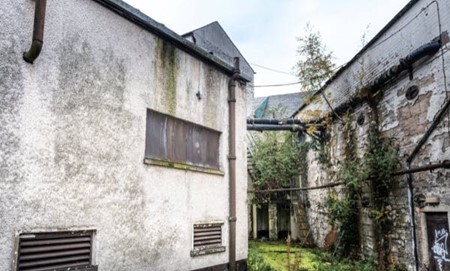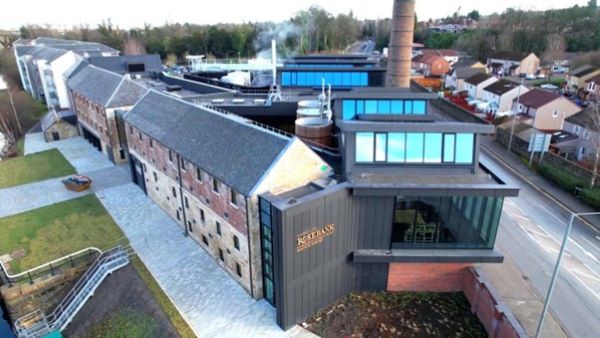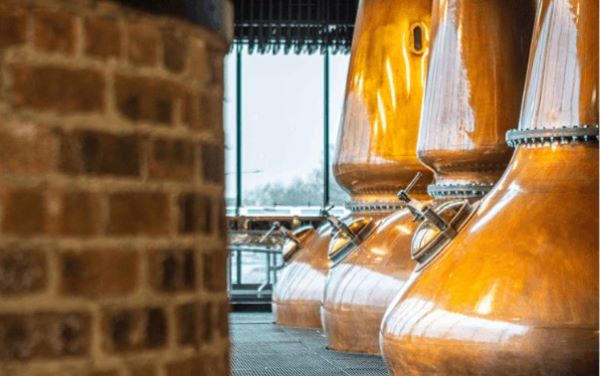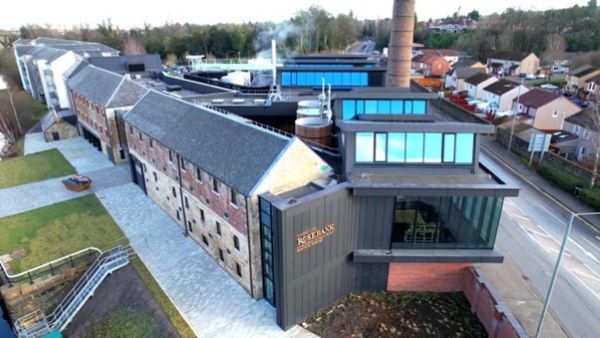Rosebank's Remarkable Resurrection
Spurned by the 'Classic Malts', Rosebank fell silent forty-one years ago and waited patiently to be redeveloped into housing with just its chimney and a small brass plaque left in its memory. Amazingly this never happened as Tom Bruce-Gardyne explains …
Today marks a big day for Rosebank and its home town of Falkirk as it flings open its doors to visitors for the first time. The famous Lowland distillery closed in 1993, seemingly for good, and with the passing years, the prospect of redevelopment edged closer. But by some miracle, it escaped the bulldozer to be rescued by Ian Macleod Distillers (IMD) in the nick of time in 2017.
"When I first saw it, it was in such a sad, dilapidated state with most of doors crow-barred open, and it was full of copulating pigeons," recalls the firm's MD, Leonard Russell. My memories of it from 2017 were of weeds sprouting from gutters, cracked windows and a crude hammer and sickle spray-painted on a wall by Falkirk's answer to Banksy.

While its single malt had a small, devoted fanbase that expanded after the distillery's closure, absence makes the heart grow fonder in whisky as in life, it was still a bold move by IMD. Rosebank's rebuilding was plagued with delays and escalating costs, thanks to Covid and the constraints of developing a cramped, urban site, but the gamble looks set to pay off. The new distillery, a blend of Victorian red brick and modern plate glass and back zinc, is a bold statement of intent.

History could have been very different. Rosebank had been owned by DCL, later UDV (now Diageo) who viewed single malts with suspicion – a passing fad most likely. Finally, in 1988, UDV plunged in with the 'Classic Malts', leveraging its vast spread of distilleries to promote regional styles. Six distilleries were invited to join the 'Classic Malt' plinth, and in terms of quality Rosebank was the obvious contender from the Lowlands.
But Falkirk and its distillery were not looking their best at the time. The Forth & Clyde Canal on whose banks Rosebank had stood since 1840 had closed and its subsequent reopening came too late. One can picture someone from UDV's head office peering at the stagnant water and shaking their head. So, it was Glenkinchie, nestled in lush, East Lothian farmland, that was picked for the plinth. That decision sealed the fate of both distilleries.
Today Glenkinchie is promoted as 'one of the four corners of Scotland … at the heart of Johnnie Walker' and has a large Striding Man sculpture to greet visitors at its entrance. That could have been Rosebank's destiny, though it would be even less of 'a corner' being bang in the middle of the Central Belt.
The Classic Malts helped take the category mainstream and gave consumers a way to navigate their way in. Those who were particularly nervous could stay on the plinth as they progressed from an 'introductory' Glenkinchie, to the Highlands until ready for the rugged, peat-soaked embrace of Lagavulin on Islay.
All that is now rather old hat, and the idea of 'regional malts' doesn't get you very far, not least because distillers are happy to make any style of whisky regardless of location - a point made by IMD's Gordon Dundas who says: "Lagg, the new distillery in Arran is a heavily-peated Lowland in theory."
Books on Scotch whisky, my own included, tend to take a regional approach. Having covered the storm-tossed distilleries of the Western Isles, those in the Highlands and Speyside, there is space for a lament on Campbeltown's glorious past and a brief chapter on the Lowlands' sole survivors - Glenkinchie and Auchentoshan.
"If you look at the Lowland region now, there are twenty distilleries," says Gordon, and it's true there has been a remarkable resurgence of whisky-making, from the Borders to Edinburgh, Glasgow and the Kingdom of Fife. However, few describe themselves as 'Lowland', and he says of Rosebank: "The thing we won't be pushing particularly is the idea it's 'a typical Lowland style', rather it's just a great whisky."

Old Rosebank never was 'typical'. Its Irish-style, triple distillation pointed to a delicate spirit, but its traditional worm-tub condensers pulled it the other way, adding weight and depth. That unique combination has been replicated in the new distillery, though a fully-matured whisky is some way off. At the distillery launch party earlier this week, a 33 year-old Rosebank had a delicious lingering finish, but I'm not sure it will linger for a decade until the first new Rosebank is ready.
If there is a style shared with others in the region, it has something to do with subtlety and nuance. Rosebank's newmake spirit feels naked. When it finally comes of age, it will have no pungent peat smoke or rich sherry cask to hide behind. It may not put hairs on your chest, but at least half the population don't want that look.
However, the lure of the Highlands remains strong. This summer, despite the midges, even the most flea-bitten B&B in Fort William will have no vacancies until October, while the Isle of Skye might sink beneath the weight of its tourist hoards. Falkirk, helped by its shiny new, visitor-friendly distillery, its easy access to Edinburgh and Glasgow and its only very occasional midge, is hoping to reverse that trend a little.
To what extent the world's whisky drinkers are still swayed by the word 'Highland' and images of misty lochs and mountains is hard to say, but Rosebank and its neighbours will be urging them to look beyond the label.
In hindsight it was probably a blessing that Rosebank never joined the plinth to be promoted as an 'introductory malt' or, worse, 'one for the ladies', until reinvented as a Johnnie Walker satellite. Quite how it dodged the wrecking ball during those silent years is the real mystery. But it did, and today, beautifully restored and back at work, it feels in good hands.

Award-winning drinks columnist and author Tom Bruce-Gardyne began his career in the wine trade, managing exports for a major Sicilian producer. Now freelance for 20 years, Tom has been a weekly columnist for The Herald and his books include The Scotch Whisky Book and most recently Scotch Whisky Treasures.
You can read more comment and analysis on the Scotch whisky industry by clicking on Whisky News.




